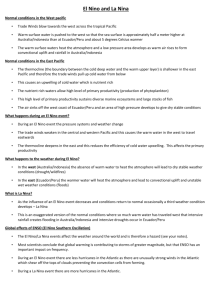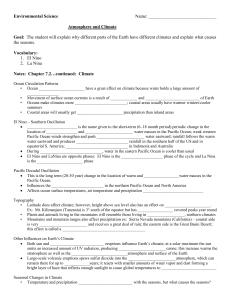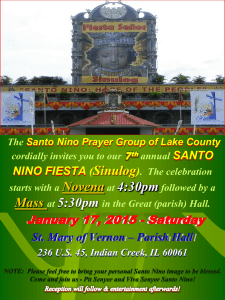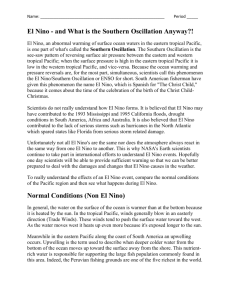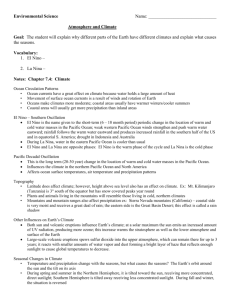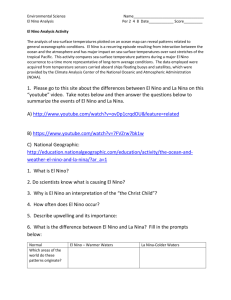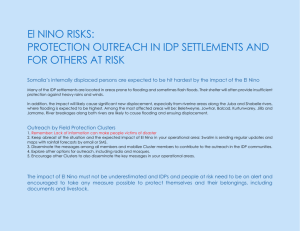El-Nino Conditions
advertisement
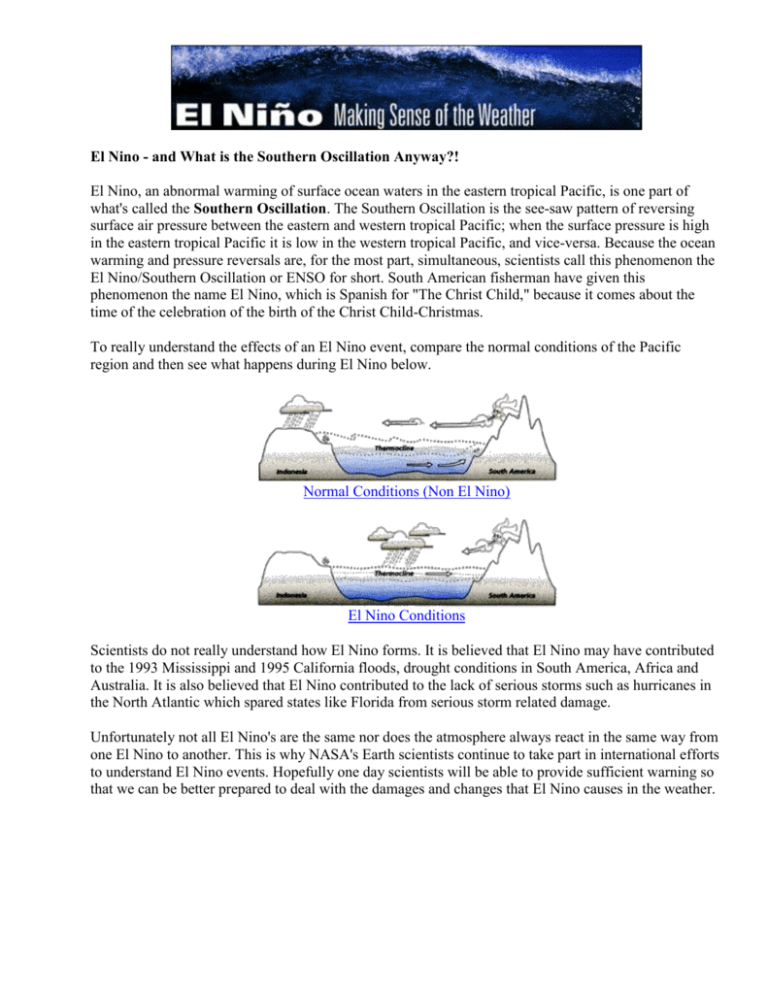
El Nino - and What is the Southern Oscillation Anyway?! El Nino, an abnormal warming of surface ocean waters in the eastern tropical Pacific, is one part of what's called the Southern Oscillation. The Southern Oscillation is the see-saw pattern of reversing surface air pressure between the eastern and western tropical Pacific; when the surface pressure is high in the eastern tropical Pacific it is low in the western tropical Pacific, and vice-versa. Because the ocean warming and pressure reversals are, for the most part, simultaneous, scientists call this phenomenon the El Nino/Southern Oscillation or ENSO for short. South American fisherman have given this phenomenon the name El Nino, which is Spanish for "The Christ Child," because it comes about the time of the celebration of the birth of the Christ Child-Christmas. To really understand the effects of an El Nino event, compare the normal conditions of the Pacific region and then see what happens during El Nino below. Normal Conditions (Non El Nino) El Nino Conditions Scientists do not really understand how El Nino forms. It is believed that El Nino may have contributed to the 1993 Mississippi and 1995 California floods, drought conditions in South America, Africa and Australia. It is also believed that El Nino contributed to the lack of serious storms such as hurricanes in the North Atlantic which spared states like Florida from serious storm related damage. Unfortunately not all El Nino's are the same nor does the atmosphere always react in the same way from one El Nino to another. This is why NASA's Earth scientists continue to take part in international efforts to understand El Nino events. Hopefully one day scientists will be able to provide sufficient warning so that we can be better prepared to deal with the damages and changes that El Nino causes in the weather. Normal Conditions (Non El Nino) In general, the water on the surface of the ocean is warmer than at the bottom because it is heated by the sun. In the tropical Pacific, winds generally blow in a easterly direction. These winds tend to push the surface water toward the west also. As the water moves west it heats up even more because it's exposed longer to the sun. Meanwhile in the eastern Pacific along the coast of South America an upwelling occurs. Upwelling is the term used to describe when deeper colder water from the bottom of the ocean moves up toward the surface away from the shore. This nutrient-rich water is responsible for supporting the large fish population commonly found in this area. Indeed, the Peruvian fishing grounds are one of the five richest in the world. Normally, strong trade winds blow from the east along the equator, pushing warm water into the Pacific Ocean. The thermocline layer of water is the area of transition between the warmer surface waters and the colder water of the bottom. Because the trade winds push surface water westward toward Indonesia, the sea level is roughly half a meter higher in the western Pacific than in the east. Thus you have warmer, deeper waters in the western Pacific and cooler, shallower waters in the east near the coast of South America. The different water temperatures of these areas affect the types of weather these two regions experience. TOPEX/POSEIDON global topography maps are used to study ocean surface circulation. Here the highest sea elevation (shown in red) is in the western Pacific Ocean. In the east the water cools the air above it, and the air becomes too dense to rise to produce clouds and rain. However; in the western Pacific the air is heated by the water below it, increasing the buoyancy of the lower atmosphere thus increasing the likelihood of rain. This is why heavy rain storms are typical near Indonesia while Peru is relatively dry. El-Nino Conditions El Nino happens when weakening trade winds (which sometimes even reverse direction) allow the warmer water from the western Pacific to flow toward the east. This flattens out the sea level, builds up warm surface water off the coast of South America, and increases the temperature of the water in the eastern Pacific. An El Nino condition results from weakened trade winds in the western Pacific Ocean near Indonesia, allowing piled-up warm water to flow toward South America. The deeper, warmer water in the east limits the amount of nutrient-rich deep water normally surfaced by the upwelling process. Since fish can no longer access this rich food source, many of them die off. This is why these conditions are called "El Nino", or "the Christ Child", which is what Peruvian fisherman call the particularly bad fishing period around December. More importantly, the different water temperatures tend to change the weather of the region. What happens to the ocean also affects the atmosphere. Tropical thunderstorms are fueled by hot, humid air over the oceans. The hotter the air, the stronger and bigger the thunderstorms. As the Pacific's warmest water spreads eastward, the biggest thunderstorms move with it. If you look on a map, you will see that suddenly islands like Tahiti, normally tropical paradises, experience massive storms. El Nino can have impacts on weather at various locations around the globe. Off the east coast of southern Africa, drought conditions often occur. In countries such as Zimbabwe, the effects of drought can be devastating. The clouds and rainstorms associated with warm ocean waters also shift toward the east. Thus, rains which normally would fall over the tropical rain forests of Indonesia start falling over the deserts of Peru, causing forest fires and drought in the western Pacific and flooding in South America. Moreover the Earth's atmosphere reponds to the heating of El-Nino by producing patterns of high and low pressure which can have a profound impact on weather far away from the equatorial Pacific. For instance, higher temperatures in western Canada and the upper plains of the United States, colder temperatures in the southern United States. The east coast of southern Africa often experiences drought during El Nino.
